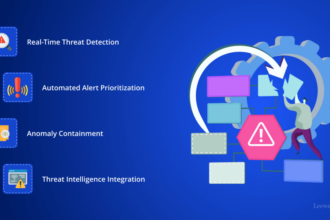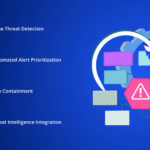In this article, I will discuss the collaborations in the tech industry, emphasizing how intercompany collaborations foster innovation, minimize expenses, and create new market opportunities.
In the context of breakthroughs like AI, 5G, and Cybersecurity, collaboration is of paramount importance. It enables firms to address multifaceted problems, set benchmarks, and ensure enduring development across the world’s technology framework.5tg
What is Tech Industry Collaborations?
Collaborations in the tech industry pertain to the alliances formed between technology companies, startups, other organizations, and even research institutions for the purpose of resource sharing, innovating, and achieving set goals.

These collaborations may encompass the development of software, hardware, and other digital solutions, technology integration, and collaborative R and D. Companies accelerate innovation, reduce risks, and expand their market reach by pooling expertise, funding, and networks. In the rapidly changing technology landscape, such partnerships are critical for fostering knowledge transfer, improving competitiveness, and driving innovation.
How To Choose Tech Industry Collaborations
Below is an easy guide on selecting collaborations in the tech industry, presented in pointers:
Align Goals and Vision: Confirm that the prospective partner has similar strategic objectives and long-term vision to avoid friction.
Evaluate Expertise: Work with companies that complement your expertise and offer crucial technology.
Assess Reputation: Evaluate the partner’s trustworthiness, previous work, and their standing in the industry.
Check Resources: Confirm that they have adequate equipment, personnel, and monetary resources to facilitate collaboration.
Consider Innovation Potential: Collaborating with such partners stimulates imagination and provides avenues to develop novel solutions.
Legal and IP Safety: Contracts should secure all IP documents and delineate roles to avoid ambiguity.
Key Point & Tech Industry Collaboration List
| Collaboration | Key Point |
|---|---|
| Microsoft × Adobe | Enhances cloud-based creative and productivity tools integration. |
| NVIDIA × HPE | Accelerates AI and high-performance computing solutions. |
| Google Cloud × SAP | Combines cloud infrastructure with enterprise resource planning software. |
| Apple × TSMC | Strengthens semiconductor production for advanced chips. |
| Intel × Brookfield | Invests in semiconductor manufacturing and technology infrastructure. |
| Amazon × Anthropic | Advances AI research and safe AI model development. |
| OpenAI × PwC | Provides AI consulting and enterprise integration solutions. |
| Samsung × IBM | Develops next-gen AI, semiconductors, and enterprise technology solutions. |
1.Microsoft × Adobe
The partnership of Microsoft and Adobe stands as one of the most important in tech as it combines productivity and creative solutions. Organizations enjoy streamlined business processes, superior document handling, and improved workflow collaboration with integrated Adobe creative cloud tools and Microsoft’s cloud and enterprise platforms.

This collaboration is driven by the Microsoft enterprise footprint and Adobe’s design capabilities and integrates creativity and productivity technology by promoting innovation in digital experiences. This is a collaboration of the tech industry as it integrates technology, resources, and proficiency to forge more efficient and imaginative solutions in the hands of users worldwide.
2.NVIDIA × HPE
The collaboration between NVIDIA and HPE is a clear example of the synergies to be gained from a partnership in the field of high-performance computing and artificial intelligence. NVIDIA’s GPUs and AI technologies, paired with HPE’s enterprise-grade infrastructure, allow for the expeditious processing of large datasets and the efficient execution of intricate AI models by organizations.

This partnership vividly demonstrates the benefit of innovation-by-collaboration, which integrates technological infrastructure and hardware with scalable enterprise-grade infrastructure for the advancement of AI research, scientific computing, and data-intensive business solutions, thus accelerating innovation in several industries.
3.Google Cloud × SAP
The intersection of Google Cloud and SAP marks a notable collaboration in the technology sector, as it incorporates the use of cloud technology within business software solutions. Companies can now maximize efficiency, improve data processing, and refine their decision-making processes with SAP’s ERP systems integrated into Google Cloud’s infrastructure and AI solutions.
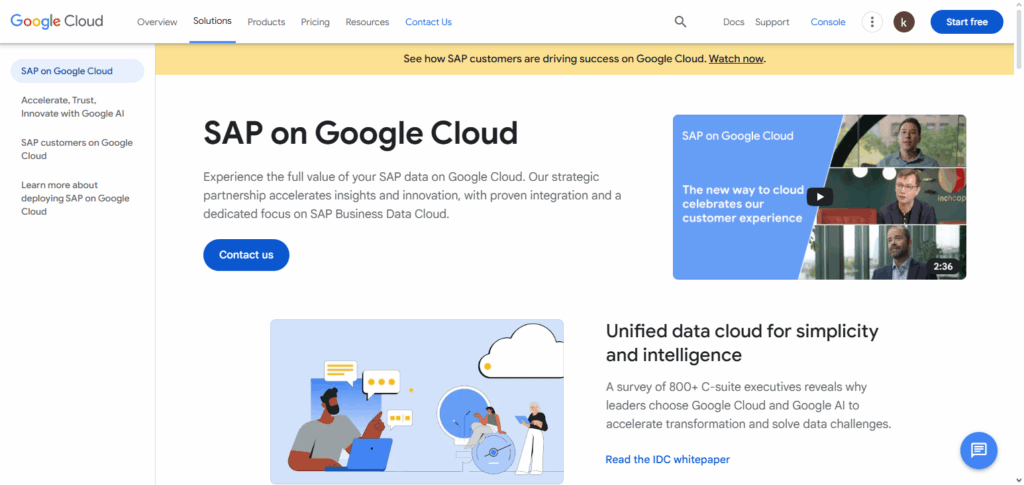
This partnership exemplifies collaboration within the technology industry, as it integrates cloud computing and specialized business software, accelerates innovation, automates workflows, and transforms enterprises on a global scale.
4.Apple × TSMC
The Apple and TSMC collaboration is an exemplary collaboration within the tech industry focusing on the production of semiconductors as each company possesses the other’s competitive advantage. Apple depends upon TSMC’s high-technology fabrication facilities to create and manufacture chips for iPhones, iPads, and even the Macs which are high-performance and use energy efficiently.

This collaboration shows the extent of TSMC’s prowess in manufacturing as the combination of Apple’s innovation and TSMC’s fabrication The collaboration speeds up advancements in the fabrication of chips and at the same time work toward the improvement of the consumer electronic apparatus economics.
5.Intel × Brookfield
The collaboration between Intel and Brookfield is strategically positioned within the tech industry to enhance the manufacturing capabilities and infrastructure within the semiconductor sector. Leveraging Intel’s proficiency in semiconductor fabrication and chip architecture along with Brookfield’s investment and real estate ventures, the partnership seeks to construct cutting-edge semiconductor manufacturing facilities and associated infrastructure.

This collaboration exemplifies tech industry collaboration as it integrates innovation with infrastructure investment, thereby enhancing the pace of fabrication, supply chain resilience, and fulfilling international market needs for sophisticated semiconductor technology, thus fostering competitive advancement within the semiconductor industry.
6.Amazon × Anthropic
The collaboration between Amazon and Anthropic stands out as one of the collaborations in the technology industry which focuses on the development of safe and scalable artificial intelligence.
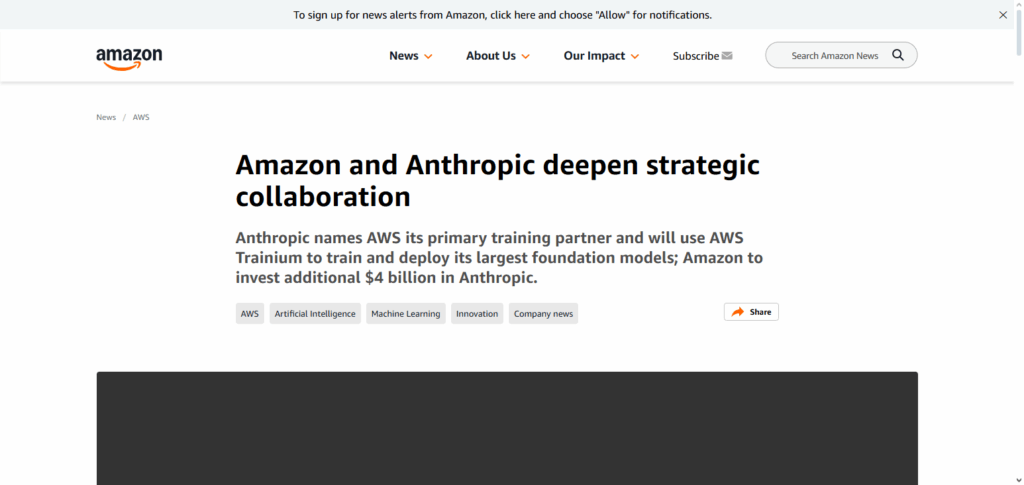
The partnership leverages Amazon’s cloud infrastructure and computational resources along with Anthropic’s AI research and safety skills, thus accelerating the development of AI models of the future.
This partnership illustrates tech industry collaboration in the sense that it integrates innovation with operations by providing companies and application developers advanced AI technology tools rooted in safe and ethical AI practices across diverse industries and countries.
7.OpenAI × PwC
The collaboration between OpenAI and PwC exemplifies a noteworthy convergence in the technology sector, as it blends sophisticated artificial intelligence with business consultancy savoir-faire.
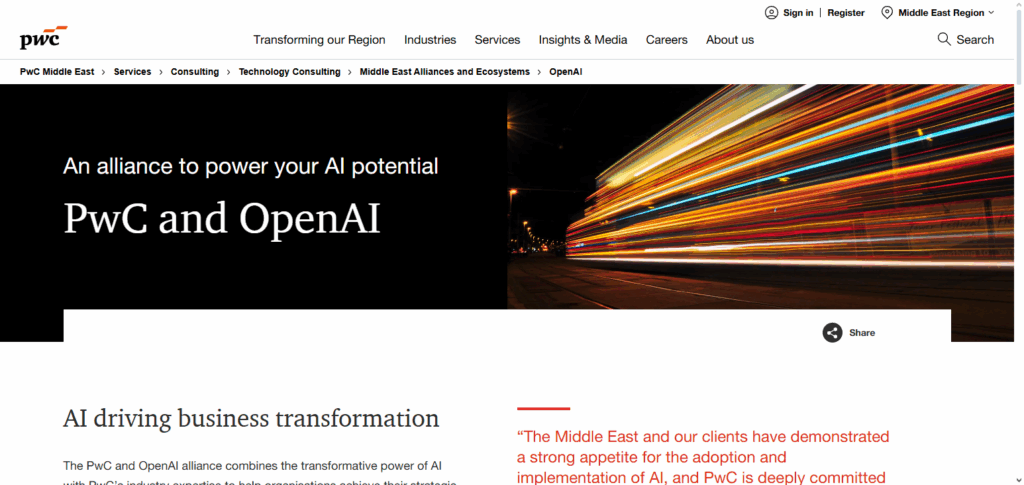
OpenAI’s advanced AI models are integrated with PwC’s vast understanding of enterprise functions and strategy, which enables the partnership to assist companies in adopting and implementing AI in an effective and ethical manner.
This collaboration epitomizes the tech industry cooperation because it combines ingenuity with utilitarian implementation to help companies improve their decision-making, streamline operations, and accelerate digital transformations with the responsible use of AI technologies.
8.Samsung × IBM
The collaboration between Samsung and IBM is one of the most striking examples of the intersection between AI and semiconductors in the context of enterprise technology solutions.

Capitalizing on Samsung’s hardware innovation and semiconductor mastery alongside IBM’s strengths in AI, cloud, and enterprise technology, the collaboration promotes the furtherance of applied research and innovation across various sectors.
This collaboration is an illustration of technologic industry collaboration based on the synergistic convergence of unique and interdependent capabilities towards the acceleration of innovation.
Pros & Cons Tech Industry Collaboration
Pros
- Innovation Boost – Notable innovations emerge in a collaborative work environment.
- Cost Efficiency – Reduction of overhead costs through collaborative work.
- Market Expansion – Reaching a greater number of potential customers through partnerships.
- Talent and Knowledge Sharing – Members from different companies contribute to a variety of skills and viewpoints.
- Standardization – Often, collaborations set benchmarks for the entire industry (5G, AI ethics, etc).
- Faster Problem Solving – Address important and multifaceted problems (cybersecurity, sustainability).
Cons
- Intellectual Property Risks – The possibility of losing proprietary technology or trade secrets.
- Competition Issues – Collaboration can erase the line that separates partners and competitors.
- Decision Making Conflicts – Variety in priorities can be a drag for progress.
- Unequal Benefits – Discrepancy in how value is apportioned between the partners.
- Cultural and Structural Differences – Organizational mismatches can lead to a lack of efficiency.
- Regulatory Issues – Issues pertaining to antitrust laws of compliance, and collaborations of that sort.
Conclusion
Collaborations within the tech industry are some of the most powerful factors of innovation, efficiency, and growth on a global scale. They enable companies to combine resources, skills, and markets to expand at a much faster rate and deal with more intricate issues like cybersecurity, AI ethics, or sustainability.
Nevertheless, partnerships come with their fair share of risks, including disputes over intellectual property, unequal value proportions, and regulatory obstacles which can significantly hinder their potential.
In the end, the interplay of partnerships boils down to trust, well-defined agreements, and common objectives. Collaborations that are well managed, in this regard, not only serve the companies that are involved but also define the future of technology towards the shaping of ‘collective agreements and solutions’ that serve the industry as a whole.
FAQ
Why do companies collaborate in tech?
To reduce costs, accelerate innovation, expand markets, share expertise, and solve large-scale challenges.
What are the risks of collaboration?
Risks include intellectual property theft, conflicts of interest, unequal benefits, and regulatory challenges.
How do collaborations impact innovation?
They boost innovation by combining diverse skills, research, and technologies to create faster, better solutions.



